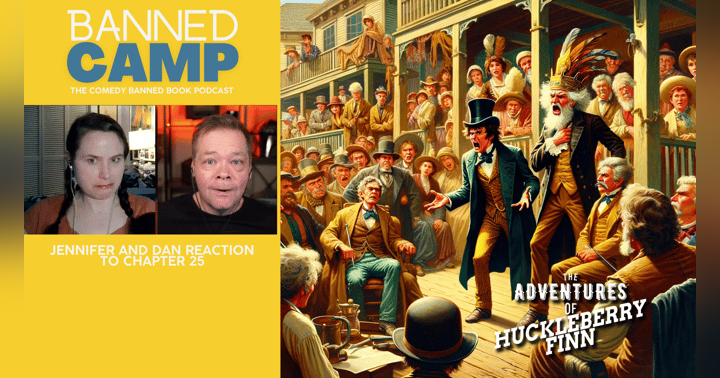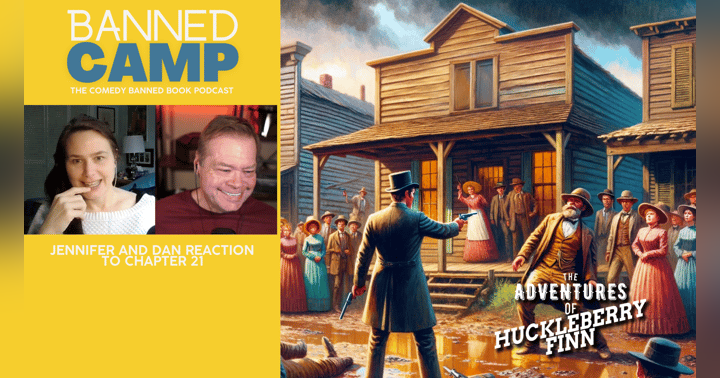Exploring Chapter 12 of Huckleberry Finn: Banned Camp's Deep Dive

Welcome to the latest exploration at Banned Camp, where we're not just reading banned books – we're diving headfirst into their turbulent waters. In our recent episode, Jennifer and Dan embarked on a riveting journey through Chapter 12 of Mark Twain's iconic "The Adventures of Huckleberry Finn." This episode isn't just another literary discussion; it's an adventure in itself. Listen to the full episode here.
In this chapter, Huck and Jim's nocturnal voyage down the Mississippi River comes alive with Twain's vivid storytelling. Their encounters – from the morally ambiguous act of stealing (or "borrowing") chickens to the adrenaline-pumping discovery of a wrecked steamboat – are not just plot points but reflections of the era's complex moral fabric. As we paddle through this chapter with Huck and Jim, we witness their struggles, triumphs, and the nuanced interplay of right and wrong in a world where the lines are as winding as the river itself.
In true "Banned Camp" fashion, we sprinkle humor into our analysis, sharing personal anecdotes that resonate with the chapter's themes. Dan's whimsical tale of his first organ recital in a wigwam and Jennifer's childhood pastime of reading about the origins of state names add a unique and humorous perspective to our discussion. So, let's set sail on this literary adventure and uncover the layers of Chapter 12 of "The Adventures of Huckleberry Finn."
What Is In Chapter 12 Of "The Adventures of Huckleberry Finn"?
Huckleberry Finn and Jim's journey is more than just a series of events; it's a tapestry woven with the threads of adventure, moral ambiguity, and the pursuit of freedom. Chapter 12 of this classic novel is a microcosm of their entire journey, packed with suspense, moral quandaries, and a dash of danger. To fully immerse yourself in the world of Huck and Jim, catch up on all of the Banned Camp Episodes about "The Adventures of Huckleberry Finn" here.
As Huck and Jim navigate the mighty Mississippi, they embody the quintessence of adventure. The duo travels under the cloak of night, concealing their raft during the day – a strategy that mirrors their own hidden desires and uncertainties. Huck's controversial decisions, from procuring provisions in towns to contemplating the morality of 'borrowing' chickens, spotlight his inner conflict between societal norms and personal beliefs.
The chapter's crescendo arrives with the discovery of a wrecked steamboat, igniting a debate between Huck's adventurous spirit and Jim's cautious wisdom. Huck, inspired by the daring exploits of Tom Sawyer, insists on exploring the steamboat, leading to an unexpected and harrowing encounter with thieves plotting a murder. This moment is a pivotal point in the novel, presenting a vivid tableau of danger and ethical dilemmas.
Through these events, Twain masterfully blends adventure with a profound exploration of societal issues, reflecting the complex world Huck and Jim navigate. Chapter 12 is not just a segment of their journey; it's a mirror reflecting the intricate dance of freedom, morality, and survival in the antebellum South.
Character Development
In "The Adventures of Huckleberry Finn," character development is not just about personal growth; it's about the characters' evolving perceptions of the world and their place within it. Chapter 12 serves as a crucible for this development, particularly for Huck and Jim.
Huck, still grappling with the morals instilled by society versus those he's discovering on his journey, faces dilemmas that challenge his understanding of right and wrong. His contemplation about stealing – a practice casually endorsed by his father but condemned by the widow – highlights his inner conflict. This chapter showcases Huck's moral elasticity, as he navigates through shades of grey, rather than clear-cut notions of right and wrong.
Jim, on the other hand, emerges as a voice of reason and caution. His reluctance to board the wrecked steamboat contrasts sharply with Huck's impulsive curiosity. This interplay between caution and curiosity not only deepens their character arcs but also reinforces the dynamic of their relationship. Jim's presence is more than just a companion to Huck; he's a moral compass, often guiding them through the fog of ethical ambiguity.
This chapter's events intensify their character development, pushing them towards critical self-reflection. As they confront robbers and navigate perilous situations, both Huck and Jim are forced to reassess their values and beliefs. It's in these moments of crisis that their characters are truly tested and shaped, providing a deeper understanding of their complex personalities.
In "Banned Camp's" discussion of Chapter 12, Dan and Jennifer delve into these nuances, bringing to light the subtleties of Huck's and Jim's evolving characters. Their analysis adds layers to our understanding of these iconic figures, revealing how their journey is as much inward as it is down the mighty Mississippi.
Themes and Symbols in Chapter 12 of "The Adventures of Huckleberry Finn"
In Chapter 12 of "The Adventures of Huckleberry Finn," Mark Twain intricately weaves themes and symbols that are central not only to this chapter but to the entire novel. The Mississippi River, a dominant presence in this chapter, serves as more than just a physical setting. It's a symbol of freedom, escape, and the constant flow of life, yet paradoxically, it's also a route leading Huck and Jim towards the deep South, away from the freedom they seek. This contradictory movement southwards sparks questions about the true nature of freedom and escape in the context of Huck and Jim's journey.
Another crucial theme in this chapter is the moral ambiguity of actions. Huck's recounting of his father's justifications for stealing, contrasted with the widow's moral teachings, highlights the blurred lines between right and wrong in Huck's world. This theme is further explored when Huck and Jim encounter the robbers on the steamboat. The decision to plunder, and the subsequent plan to save the robber intended to be left to drown, emphasizes the complexity of moral choices in desperate circumstances.
The steamboat, wrecked and chaotic, symbolizes the societal breakdown and the moral decay Huck and Jim face on their journey. It's a microcosm of the larger world they navigate, full of danger, moral dilemmas, and the unpredictable nature of human intentions.
These themes and symbols contribute significantly to the depth and enduring relevance of Twain's work, inviting readers and listeners like those of "Banned Camp" to delve into the nuanced exploration of morality, freedom, and the human condition.
Chapter's Impact on the Overall Story of "The Adventures of Huckleberry Finn"
Chapter 12 of "The Adventures of Huckleberry Finn" is pivotal in shaping the overall narrative of Mark Twain's classic novel. This chapter marks a significant turning point in Huck and Jim's journey, both literally and metaphorically. The choices made and the events that unfold here have lasting repercussions on their adventure.
The encounter with the steamboat and the robbers represents a crucial moment of moral testing for Huck. His decision to help a potential victim, despite his own perilous situation, signifies a maturing of his moral compass. This decision is a departure from the more self-centered, mischievous behavior seen earlier in the novel and sets the stage for Huck's continued moral evolution throughout the story.
Furthermore, the drifting of the raft, their primary means of escape and symbol of their shared journey, during the steamboat episode, adds a layer of uncertainty and danger to their quest for freedom. This incident underscores the precariousness of their situation and the constant challenges they face in their pursuit of liberty and a better life.
The chapter also deepens the relationship between Huck and Jim. Their shared experiences and mutual dependence strengthen their bond, moving beyond mere companionship to a deeper, more meaningful connection. This evolving relationship is central to the novel's exploration of themes such as friendship, loyalty, and the humanity of the enslaved.
Overall, Chapter 12 serves as a critical juncture in "The Adventures of Huckleberry Finn," advancing the plot and enriching the novel's themes. It's a testament to Twain's skill as a storyteller that this chapter so effectively bridges the earlier adventures with the more profound experiences to come.
Banning Triggers: Themes from Chapter 12 of "The Adventures of Huckleberry Finn"
Chapter 12 of "The Adventures of Huckleberry Finn" delves into themes that could potentially trigger its banning, yet upon closer examination, these elements underscore the novel's literary and educational value rather than justify its censorship.
The chapter's portrayal of theft and moral ambiguity, as seen through Huck's lessons from his father and his actions on the steamboat, might raise concerns. These actions, however, are not glorified but are presented in a context that encourages critical thinking about morality and ethics. Huck's internal conflict and his evolving understanding of right and wrong serve as a powerful narrative tool to explore complex moral questions, rather than a straightforward endorsement of unethical behavior.
Moreover, the depiction of violence and criminal behavior on the steamboat could be perceived as controversial. However, Twain uses these elements to create tension and develop the plot, not to sensationalize violence. The steamboat scene is crucial for illustrating the dangers and moral dilemmas Huck and Jim face, highlighting the harsh realities of their world.
The discussions around slavery and racial stereotypes, central to the novel, are also potential triggers. Yet, it's essential to understand that Twain's work is a product of its time, and his portrayal of Jim, as well as the relationship between Jim and Huck, serves to challenge and critique the societal norms of the 19th century.
Although Jennifer and Dan recognize these themes in "Banned Camp," they rightly conclude that none provide a valid reason to ban the book. Instead, these elements should be seen as opportunities for dialogue and learning, reflecting the book's enduring relevance and educational value.
Conclusion
"Banned Camp, a comedy podcast where we read banned books and find out why they were banned in the first place. Dive into our banned book podcast to explore more."
In our journey through "The Adventures of Huckleberry Finn," particularly Chapter 12, we've traversed the realms of adventure, moral ambiguity, and complex social themes. Mark Twain's timeless novel, while subject to controversy and censorship, remains a profound commentary on human nature and societal norms. At "Banned Camp," we don't just read these banned books; we delve deep into their pages, uncovering the layers of meaning and controversy that have made them subjects of debate.
Through our discussions, we unravel the complexities of Twain's work, appreciating its historical context while also critiquing its contemporary relevance. Our journey with Huck and Jim down the Mississippi River is more than an adventure; it's an exploration of the human spirit in the face of moral dilemmas and societal constraints.
Join us at "Banned Camp" as we continue to challenge censorship, explore the depths of literary classics, and share a few laughs along the way. Our podcast is more than just a book club; it's a community of readers, thinkers, and, yes, the occasional chicken thief, coming together to celebrate the power and freedom of storytelling.
Further Reading
Mark Twain: A Life by Ron Powers
Explore the life and times of Mark Twain in this comprehensive biography. Ron Powers delves into Twain's experiences and their influence on his most famous works, including "The Adventures of Huckleberry Finn." Read more.
Was Huck Black? Mark Twain and African-American Voices by Shelley Fisher Fishkin
Shelley Fisher Fishkin's insightful book examines the African-American influence on Twain's writing, particularly in crafting the character of Jim. This exploration offers a deeper understanding of racial representation in "The Adventures of Huckleberry Finn." Discover more.
Banned in the U.S.A.: A Reference Guide to Book Censorship in Schools and Public Libraries by Herbert N. Foerstel
Herbert N. Foerstel's book is an essential resource for understanding the history and dynamics of book banning in the United States, including the case of "The Adventures of Huckleberry Finn." Learn more.










